Castro Crest from Corral Canyon Road through Upper Solstice Canyon in the Santa Monica Mountains

Between Corral Canyon Road and Castro Crest, the Backbone Trail passes though a remote segment of the Santa Monica Mountains know as Upper Solstice Canyon. While it is possible to feel quite removed at the bottom of this trail, the high ridges on both ends provide such sweeping views as to immediately restore your sense of place. From Corral Canyon Road to Castro Crest is 5.5 miles round trip with 540 feet of elevation between the low and high points of the trail. Beyond Castro Crest, one can trek another half mile up Newton Road toward the top of Castro Peak, or continue along the Backbone Trail toward Latigo Canyon Road and beyond.
There are trails going in a few directions at the top of Corral Canyon Road, making it a popular starting point for mountain bikers. Park at road’s end and locate the sign for the Backbone Trail to the left. Lace up and start hiking west.
At the start, the Backbone Trail is wide enough for an ATV, but shrinks to a more standard single-track farther into the canyon. Strung out switchbacks lead to an unmarked intersection with a wide fire road, 0.6 miles from the start. To the right, the road ascends to Castro Motorway, a fire road that connects to the top of Corral Canyon Road. To continue on the Backbone Trail, head straight through the intersection and pick up the trail on the other side. There are no further junctions between here and Castro Crest.
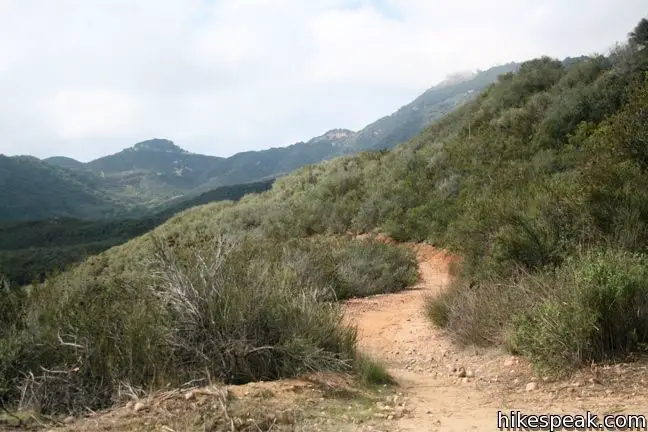
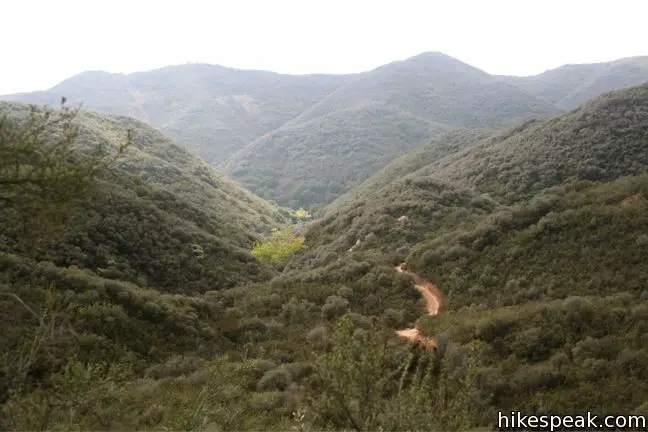
Descend the chaparral-covered slopes toward a narrow section of the canyon. After 1.3 miles, you will reach the canyon floor at an elevation of 1,725 feet. The trail turns northwest toward Castro Crest, crossing several small (and usually dry) creeks as it travels through an enchanting forest at the bottom of the canyon. Even as Upper Solstice Canyon widens, the dense woods feel surprisingly isolating.
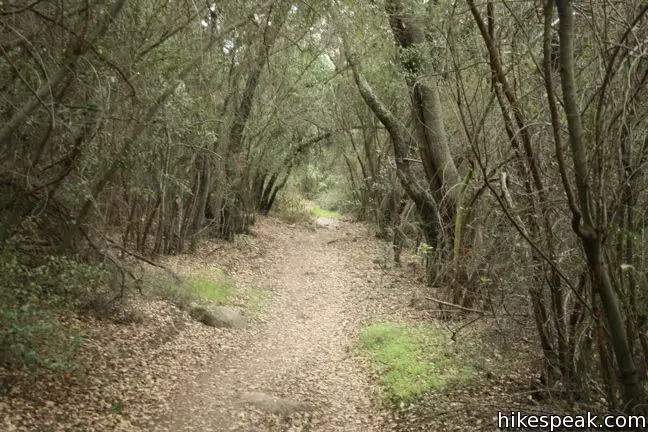
Half a mile before Castro Crest, and 2.25 miles from the start, the Backbone Trail begins to climb out of the canyon, switching up the western slope. The trees give way to broader views of Upper Solstice Canyon, offering an exceptional perspective over the world you’ve been hiking through. After ascending 540 feet from the canyon bottom, the trail reaches the saddle named Castro Crest.
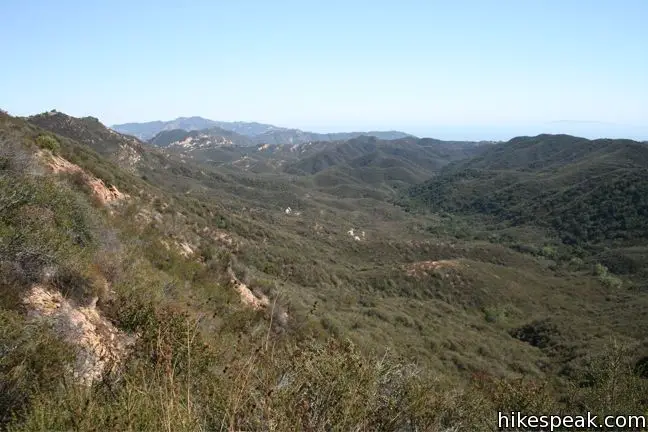
Castro Crest provides partial ocean views beyond the mountains to the south. A postcard perspective to the west exhibits the highest peaks in the range.
The Backbone Trail drops down the other side of the crest, continuing another 1.4 miles to Latigo Canyon Road. As an alternative, hikers may park along Latigo Canyon Road and venture to Castro Crest from that trailhead, for a shorter less-rustic experience that is still quite enjoyable. (Read the Latigo Canyon Road to Castro Crest trail report for more details.)
In an ideal world, one would hike from Castro Crest up Newton Road to Castro Peak and take Castro Motorway back to Corral Canyon Road. This fantastic loop was a reality for decades until recent private ownership closed the peak to through traffic including hikers. Newton Road is currently only hike-able for another half mile. The road climbs 260 feet to broader views of the Santa Monica Mountains, and is worth the extra effort. This extension creates a 6.5-mile round trip hike with 800 feet of elevation change.
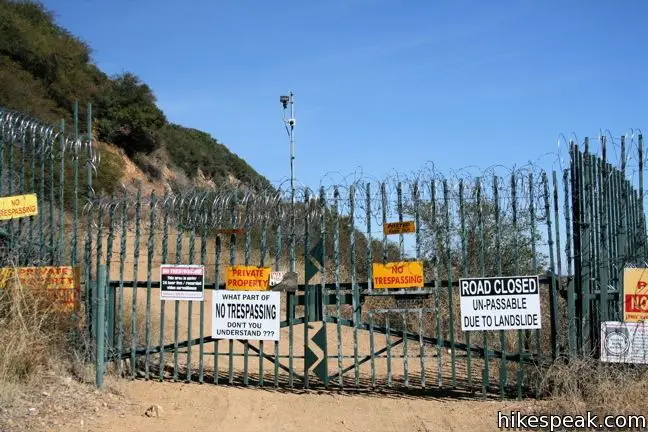
Turn right and march up Newton Road to the hike-halting security gate. You are unlikely to see a higher concentration of uniquely phrased “no trespassing” signs anywhere else on the planet. Clearly hikers are not welcome on the other side of this fence, and it is a shame. Castro Peak is the fifth highest summit in the Santa Monica Mountains at 2,824 feet, but you can only hike to 2,525 feet. No Santa Monica Mountain to the east is any taller than Castro Peak, so on a clear day the view in that direction is nearly ceaseless.
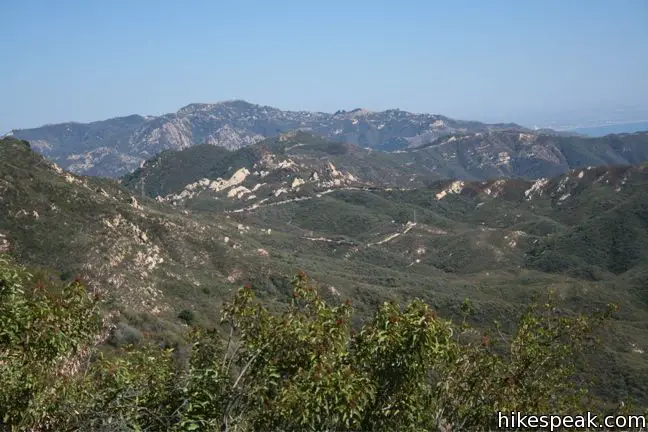
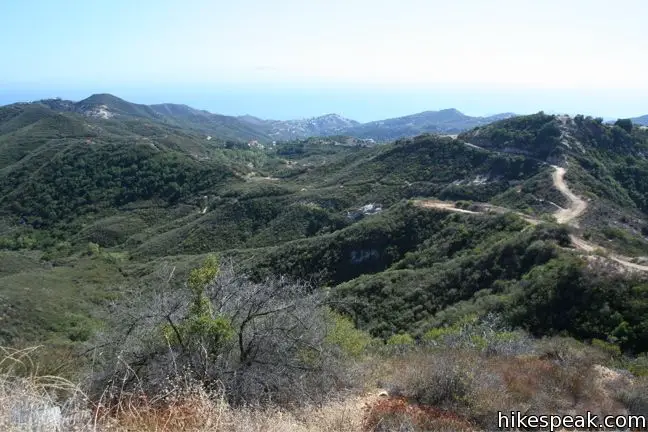
Because the gate is so imposing, you have no choice but to turn around and head back the way you came. The owners of Castro Peak should really work out a system where hikers are allowed to access the peak, if only a couple days a month. With any luck, hikers will someday again have the option to hike the scenic loop over Castro Peak.
From Corral Canyon Road to the gate above Castro Crest is 6.5 mile out and back with 750 feet of elevation between the top and bottom of the trail. Without a true summit, or waterfall, or other landmark attraction, Upper Solstice Canyon quietly provides a very appealing hikes, and may be one of the more secluded trails in the Santa Monica Mountains.
Directions to the Trailhead
- Take PCH to Malibu and turn inland on Corral Canyon Road (west of Malibu Canyon Road and Pepperdine University at the intersection with the 76 gas station).
- Drive past the entrance to Solstice Canyon and continue another 5.2 miles up Corral Canyon Road to road's end.
- Park along the right side of the road.
- Find the trailhead on the left.
Trailhead Location
Trailhead address: Castro Motorway, Agoura Hills, CA 91301
Trailhead coordinates: 34.08209, -118.75854 (34° 04′ 55.77″N 118° 45′ 30.58″W)
View Santa Monica Mountains in a larger map
Or view a regional map of surrounding Los Angeles trails and campgrounds.
 | Castro Crest from Latigo Canyon Road This 3.8-mile hike crosses a green canyon and climbs to a scenic saddle below Castro Peak. |
 | Solstice Canyon This easy and level 2.6-mile out and back hike visits the ruins of a burned down ranch and a small waterfall. |
 | Corral Canyon This 2.5-mile loop offers ocean and canyon views from a unspoiled section of the Santa Monica Mountains in Malibu. |
 | Mesa Peak from Corral Canyon Road This 6.5-mile hike travels along a ridge adorned with sandstone outcroppings to approach a peak with ocean views over Malibu. Shorten the outing to 5.35 miles round trip by stopping at a crest above Mesa Peak with a prominent boulder. |
 | Mesa Peak from Malibu Canyon Road (Piuma Trailhead) This 6.5-mile round trip hike ascends 1,375 feet up the Backbone Trail from Malibu Creek State Park to a subtle summit with substantial ocean views. |
 | Escondido Falls This 3.8-mile out and back hike visits a 200-foot waterfall that is split into two tiers. The upper tier is 150 feet tall and stunning after a rainstorm. |
 | More trails in the Santa Monica Mountains Explore other destinations in the range. |
Common Questions about Castro Crest from Corral Canyon Road through Upper Solstice Canyon in the Santa Monica Mountains
- Is the trail open?
- Yes. You should expect to find that Backbone Trail: Corral Canyon Road to Castro Crest is open. There are no recent reports of trail closures. If you discover that the trail is closed, please help your fellow hikers by reporting a closure.
- Is this trail free to access?
- Yes, Backbone Trail: Corral Canyon Road to Castro Crest is free to access. No entrance fee, pass, or permit is required. If you discover that access rules have changed, please provide feedback on your experience.
- How much time does this hike take?
- It takes approximately 2 hours 30 minutes to hike Backbone Trail: Corral Canyon Road to Castro Crest. Individual hiking times vary. Add extra time for breaks and taking in the views.
- How long is this hike?
- The hike to Backbone Trail: Corral Canyon Road to Castro Crest is 5.5 to 6.5 miles (out and back) with 540 to 800 feet of elevation change.
- Are dogs allowed on this trail?
- Yes, dogs are allowed on Backbone Trail: Corral Canyon Road to Castro Crest. The trail is open to hikers, dogs, bikes.
- What mountain range is this trail in?
- Backbone Trail: Corral Canyon Road to Castro Crest is located in the Santa Monica Mountains.
- Where is the trailhead located?
- The trailhead for Backbone Trail: Corral Canyon Road to Castro Crest is located in Agoura Hills, CA.
Trailhead Address:
Castro Motorway
Agoura Hills, CA 91301
Trailhead Coordinates:
34.08209, -118.75854 - What are the driving directions to the start of the hike?
To get to the trailhead: Take PCH to Malibu and turn inland on Corral Canyon Road (west of Malibu Canyon Road and Pepperdine University at the intersection with the 76 gas station). Drive past the entrance to Solstice Canyon and continue another 5.2 miles up Corral Canyon Road to road's end. Park along the right side of the road. Find the trailhead on the left.
View custom Google Maps directions from your current location.
- Are there other trails near Backbone Trail: Corral Canyon Road to Castro Crest?
- Yes, you can find other nearby hikes using the Hikespeak Hike Finder Map.



















I hiked the top part of this up to the gate. Yes, it is disappointing and strange to see such dire warnings in such a beautiful place. On the positive side, there are a couple of good places for rock scrambling, and the views are great.
Years ago I used to run the loop through the private property before there was a fence. One time they were in the process of building the fence and as I ran by they stopped and looked at me. I thought to myself, how much of a threat do they think a hiker or runner poses to them on a trail? Especially because no one actually lives up on the peak or would be disturbed by someone hiking by. It’s odd for sure.
A fire has come through the area recently (most likely the Woolsey fire) and most of the trees are just blackened skeletons, though a few are coming back. The middle part of the hike (in the canyon) is probably the most scenic part. Go early as there’s very little shade along most of the trail. If you can start ascending to the crest before noon, you’ll get some shade from the mountain and trail itself as you hit the switchbacks.
[…] for you here. Strap on that helmet, grab your handlebars and head out for a 5.5 mile ride on Castro Crest from Corral Canyon Road through Upper Solstice Canyon in the Santa Monica […]